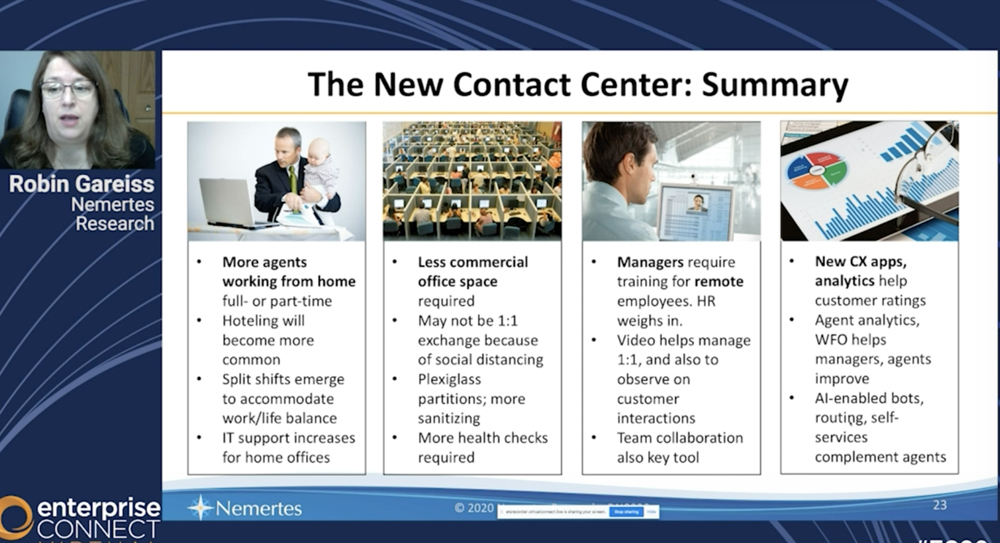As the COVID-19 pandemic continues, IT professionals are assessing their priorities, particularly in collaboration and contact center implementations. With the 2021 budget season approaching, IT leaders need to determine the best use of those dollars and build a convincing case for senior leadership.
“Most companies say the pandemic experience will change their collaboration strategies,” said Robin Gareiss, founder, Nemertes Research, in a recent Enterprise Virtual Connect session, “How the Pandemic Changed IT Spending and Plans.” She noted that keeping employees engaged and feeling connected in the work from home (WFH) setting is a top priority for many organizations.
However, managing employees remotely remains a challenge for most organizations, she said. “Key issues include security, Internet performance, network infrastructure and getting the right equipment to your people.”
Steps to take now
In her presentation, Gareiss recommended that IT professionals take the following steps:
• Reevaluate employee and agent WFH, based on several months’ experience with the pandemic. “Start measuring success, if you’re not already doing so,” she said. “Determine the metrics important to your organization and measure how they differ with agents at home.”
• Make WFH successful through a deliberate approach. That means equipping employees with the right tools. “Make sure they are able to grow in their professions,” Gareiss said. “Embrace the benefits of online learning, video and collaboration tools.”
• Establish training programs for remote management. Don’t assume managers and supervisors already have the skills to be effective in a WFH setting.
• Don’t ignore hybrid approaches. “Keep those in-person interactions alive,” she said, adding that remote delivery of services varies by sector. For instance, healthcare, manufacturing and distribution typically require workers to gather together, while adhering to health and safety guidelines. A hybrid approach could also be considered a risk mitigation strategy in the event of a future disaster that prevents employees from working from home.
• Prepare to make recommendations to the chief financial officer (CFO) for desired shifts in spending priorities. “Take a comprehensive approach and evaluate business metrics and strategies,” she said.

The changing contact center
The COVID-19 pandemic has also led to dramatic shifts in the contact center, as agents who once commuted to a physical facility every day now work from their homes. But IT leaders need to be thinking ahead to 2021, and look at their options for delivering an engaging customer experience (CX).
One lesson from the pandemic is that flexible work schedules and locations can improve employee morale and quality of life, Gareiss said. That contributes to delivering a better CX, and can reduce agent turnover. “Video collaboration can help managers support agents and observe their interactions with customers,” she added.
In the next year, Gareiss expects the “hoteling” strategy to become more common, as agents split their time between the physical facility and working from home. For instance, different agents might share the same desk on different days or shifts, to reduce exposure risk and accommodate work/life balances.
Best practices for on-premise contact centers today include temperature checks, dual monitors (sanitized), cubicles at least 6 feet apart, Plexiglas between cubes and high-quality headsets (same as at home)
Less commercial office space may be required for contact centers, although a smaller on-premises workforce may still require adequate space for social distancing on the job.
Gareiss said the cost of office space varies, but on average about $8,300 per agent per year. “Shifting to hoteling and moving agents home part time can deliver significant cost savings,” Gareiss said, noting that one 500-agent contact center is saving more than $2 million per year.
Along with weighing the pros and cons of in-person contact centers and remote agents, IT leaders should also consider investing in new CX apps and analytic tools. “Your spending priorities might include AI-enabled bots, and self-service tools to complement your live agents,” she said. “Now is the time to be thinking about you 2021 priorities.”

I’d perpetually want to be update on new posts on this site, bookmarked! .